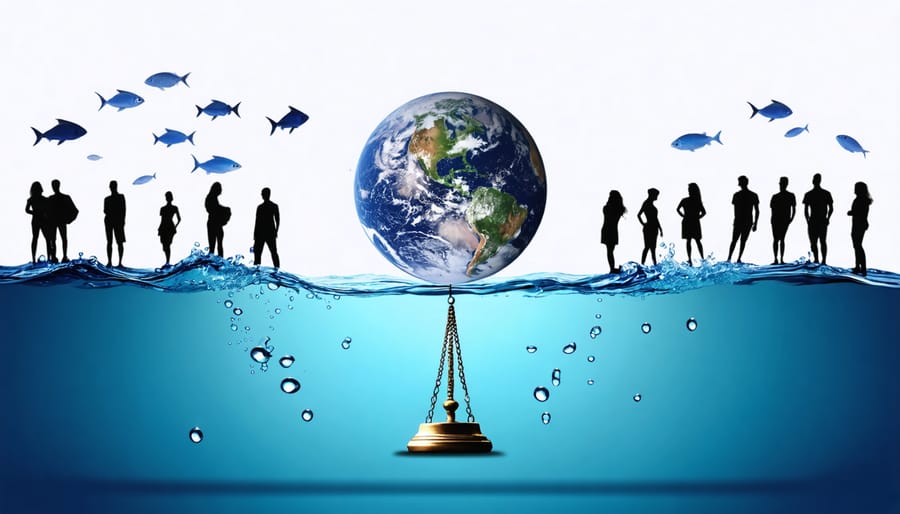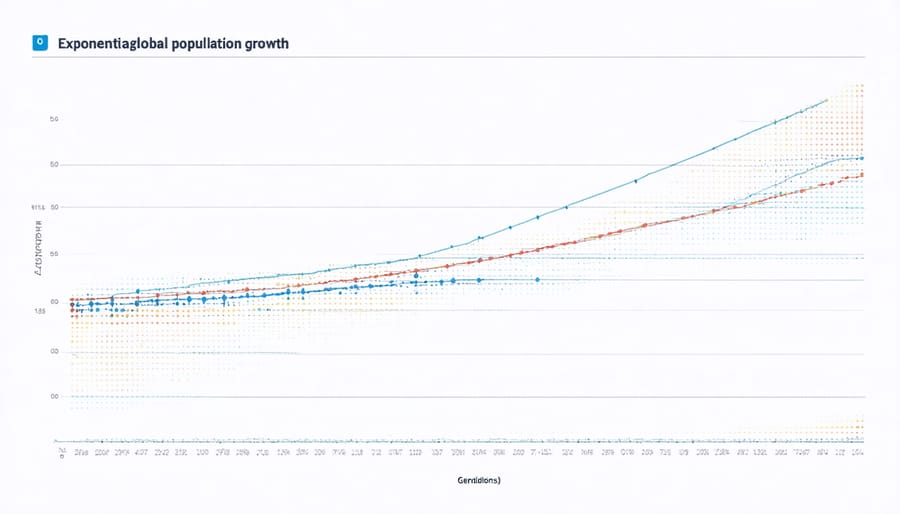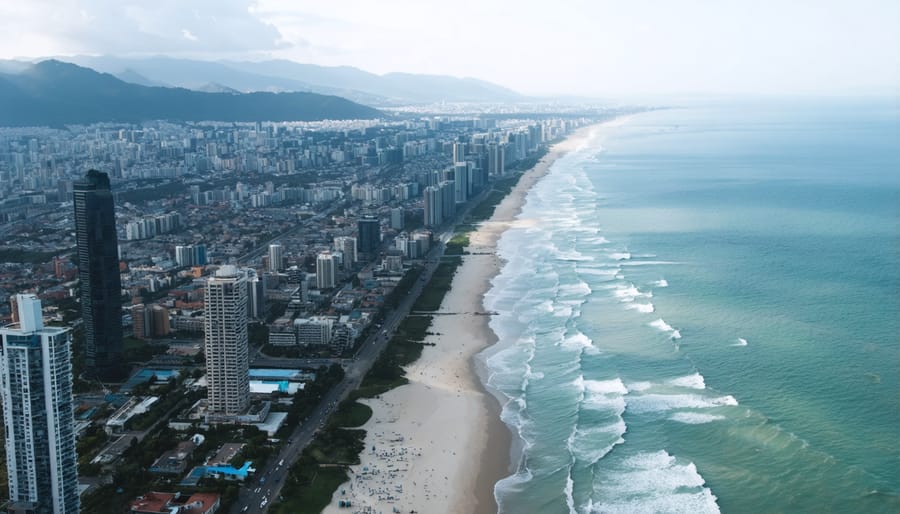
As the global population surges toward 8 billion, humanity finds itself straddling a precarious tipping point. Rapid growth is placing unprecedented strain on the planet’s finite resources and fragile ecosystems, threatening the very foundations of our survival. Nowhere is this existential crisis more apparent than in our oceans – the lifeblood of Earth.
Marine environments are buckling under the weight of human pressures. Overfishing, pollution, habitat destruction, and climate change – all fueled by soaring population numbers – are unraveling the delicate balance of underwater ecosystems. Coral reefs, the rainforests of the sea, are bleaching into oblivion. Fish stocks are collapsing as demand outpaces nature’s ability to replenish. Plastic waste chokes the life from our waters.
The stakes could not be higher. Oceans produce over half of the world’s oxygen, absorb a third of CO2 emissions, and feed billions. If marine systems fail, the consequences for humanity will be catastrophic. To chart a sustainable course, we must confront the intersections of demography and ecology head-on. While the challenges are immense, science-based solutions exist – from expanding marine protected areas to curbing carbon emissions.
The path forward demands a collective awakening – a recognition that our fate and the oceans’ are inextricably linked. In the face of relentless growth, sustainability hinges on our willingness to live in harmony with nature’s limits before they are erased forever. The future of our blue planet hangs in the balance.
The Scope of Global Population Growth

Historical Population Trends
The human population has grown exponentially over the past few centuries, driven by advancements in medicine, agriculture, and technology. In 1800, the global population stood at around 1 billion people. It took 130 years to reach 2 billion in 1930, but only 30 more years to hit 3 billion in 1960. Since then, the population has more than doubled, surpassing 8 billion in 2022.
Several key drivers of population growth have fueled this rapid increase, including improved healthcare leading to longer lifespans and reduced infant mortality rates. Technological progress in agriculture has allowed more people to be fed, while urbanization has led to higher population densities.
However, this growth has not been evenly distributed across the globe. Developing countries have experienced the most rapid growth rates, while populations in many developed nations have stabilized or even begun to decline. Understanding these historical trends is crucial for predicting future growth patterns and their potential impacts on the planet’s resources and ecosystems.
As we grapple with the challenges of sustainable development, it’s important to recognize that population growth is just one part of a complex equation that also includes consumption patterns, resource management, and technological innovation. By studying the lessons of history, we can work towards a future where human needs are met without compromising the health of our planet.
Future Population Projections
According to the latest projections from the United Nations, the world’s population is expected to reach 8.5 billion by 2030, 9.7 billion by 2050, and 10.9 billion by 2100. These numbers highlight the pressing need to address the sustainability challenges that come with rapid population growth. As more people inhabit the planet, the demand for resources like food, water, and energy will continue to rise, putting increased pressure on our oceans and marine ecosystems.
The implications of these population projections are far-reaching. With more mouths to feed, there will be a greater reliance on marine food sources, leading to overfishing and the degradation of marine habitats. Coastal development to accommodate growing populations will result in the destruction of vital ecosystems like coral reefs, mangroves, and seagrass beds. Moreover, the increased production of waste and pollution associated with larger populations will further strain the health of our oceans.
To mitigate these impacts, it is crucial that we take action now to promote sustainable practices and protect marine biodiversity. This includes adopting sustainable fishing methods, reducing our reliance on single-use plastics, and supporting conservation efforts to safeguard critical marine habitats. By working together to address the challenges posed by population growth, we can help ensure a more sustainable future for our oceans and the countless species that call them home.
Population Pressures on Marine Environments
Overfishing and Bycatch
As the global population continues to grow, so does the demand for seafood, leading to overfishing and unsustainable fishing practices that threaten marine ecosystems. Overfishing occurs when fish are caught faster than they can reproduce, causing populations to decline rapidly. This not only affects the targeted species but also disrupts the delicate balance of entire marine food webs. Additionally, unsustainable fishing methods like bottom trawling and the use of massive nets can destroy critical habitats and result in substantial bycatch—the unintended capture of non-target species. Bycatch often includes endangered animals like sea turtles, sharks, and marine mammals, further exacerbating the strain on already vulnerable populations. The combination of overfishing and destructive fishing practices driven by growing consumer demand poses a severe threat to the long-term health and resilience of our oceans. It is crucial that we address these issues through sustainable seafood choices, improved fishing regulations, and increased public awareness to ensure the survival of marine species for generations to come.

Coastal Habitat Loss
As coastal populations continue to grow, development along shorelines has accelerated, often at the expense of vital marine habitats. Mangrove forests, seagrass beds, and coral reefs are among the most threatened ecosystems, with an estimated 35% of mangroves and 29% of seagrass habitats lost globally since the 1970s. These unique environments provide critical nursery grounds for marine life, protect against coastal erosion and storms, and sequester significant amounts of carbon.
In Southeast Asia, for example, rapid urbanization and aquaculture expansion have led to the clearing of vast mangrove forests. Similarly, in the Caribbean, coastal development for tourism has resulted in the destruction of coral reefs and seagrass meadows. The loss of these habitats has far-reaching consequences for marine biodiversity, as they support a wide array of species, from tiny invertebrates to large predators like sharks and dolphins.
Moreover, the destruction of coastal habitats can have cascading effects on entire marine ecosystems. Without the protection and nutrient filtration provided by mangroves and seagrasses, coastal waters become more vulnerable to pollution, sedimentation, and harmful algal blooms. By prioritizing sustainable coastal management and habitat restoration efforts, we can work towards balancing the needs of growing populations with the preservation of these invaluable marine ecosystems.
Ocean Pollution
As the global population continues to grow, the strain on our oceans becomes increasingly evident. Larger populations generate more waste, leading to a surge in marine pollution that threatens the delicate balance of ocean ecosystems. Plastics are a particularly pervasive problem, with millions of tons ending up in our seas each year. These materials can take centuries to decompose, harming marine life through entanglement, ingestion, and habitat destruction. Agricultural runoff is another significant contributor to marine pollution, as excess nutrients from fertilizers and animal waste can lead to harmful algal blooms and create dead zones devoid of oxygen. As the demand for food rises with population growth, so too does the impact of agricultural pollution on our oceans. Addressing these challenges requires a multi-faceted approach, including improved waste management systems, sustainable agricultural practices, and increased public awareness about the far-reaching consequences of our actions on marine environments. By understanding the link between population growth and ocean health, we can work together to develop solutions that protect the incredible biodiversity of our seas for generations to come.
Strategies for Sustainable Population Management
Empowering Women and Girls
Empowering women and girls through education, economic opportunities, and access to family planning services is a critical strategy for slowing population growth rates and promoting sustainable development. Women’s education is particularly important, as it has been shown to delay marriage and childbearing, increase contraceptive use, and improve health outcomes for both women and their children. When women have the knowledge and means to make informed decisions about their reproductive health, they tend to have smaller, healthier families.
Moreover, providing women with economic opportunities, such as access to microfinance, vocational training, and equal pay for equal work, can enhance their autonomy and reduce their dependence on having large families for financial security. When women are empowered to participate in the workforce and contribute to household income, they are more likely to invest in their own health and the well-being of their children, leading to slower population growth and more sustainable communities.
Finally, ensuring universal access to voluntary family planning services is essential for enabling women to exercise their reproductive rights and make informed choices about the number and spacing of their children. By meeting the unmet need for contraception and providing comprehensive reproductive health education, we can help women avoid unintended pregnancies and better plan their families, ultimately contributing to more sustainable population dynamics.

Sustainable Urban Planning
As urban populations continue to grow, sustainable urban planning becomes crucial for minimizing harm to coastal zones. Strategies such as compact development, mixed-use zoning, and green infrastructure can help accommodate population growth while reducing sprawl and protecting sensitive coastal areas. For example, the city of Curitiba, Brazil has successfully implemented a master plan that concentrates growth along transit corridors, preserving green space and limiting development in ecologically important areas.
Another key strategy is the incorporation of nature-based solutions, such as living shorelines and coastal wetland restoration, which can protect against sea-level rise and storm surges while providing habitat for marine life. The Netherlands has been a leader in this approach, with projects like the Sand Motor, which uses natural processes to distribute sand along the coast and strengthen coastal defenses.
Sustainable urban water management is also critical, as runoff from cities can carry pollutants into coastal waters. Cities like Singapore have implemented comprehensive stormwater management systems that capture and treat runoff, reducing pollution and preventing flooding. In addition, promoting sustainable transportation, such as walking, cycling, and public transit, can help reduce air pollution and greenhouse gas emissions that contribute to ocean acidification and warming.
By integrating these strategies into urban planning, cities can accommodate growing populations while minimizing their impact on coastal zones. However, it will require a concerted effort from policymakers, planners, and citizens to prioritize sustainability and work towards a more resilient future for our oceans and communities.
Ecosystem-Based Fisheries Management
As global fish consumption continues to rise, it is crucial to adopt sustainable fishing practices that consider the growing pressures on marine ecosystems. Ecosystem-based fisheries management (EBFM) offers a holistic approach to managing fisheries by considering the entire ecosystem, including humans, rather than focusing on single species. This approach recognizes the complex interactions between fish populations, their habitats, and the people who depend on them for food and livelihoods.
EBFM involves setting catch limits based on the health of the entire ecosystem, protecting essential fish habitats, and reducing bycatch of non-target species. By taking into account the impacts of fishing on the broader marine environment, ecosystem-based management approaches aim to maintain the delicate balance of marine ecosystems while supporting sustainable fisheries.
Implementing EBFM requires collaboration among fisheries managers, scientists, and stakeholders to develop comprehensive management plans that consider ecological, social, and economic factors. This includes monitoring fish populations and their habitats, assessing the impacts of fishing activities, and adapting management strategies as needed to ensure long-term sustainability.
By embracing ecosystem-based fisheries management, we can work towards maintaining healthy marine ecosystems that can support the growing demand for seafood while preserving the incredible biodiversity of our oceans for future generations.
Conclusion
In conclusion, addressing population growth is crucial for the long-term sustainability of our oceans and the countless species that inhabit them. As human populations continue to expand, so too do the pressures we place on marine ecosystems through overfishing, pollution, coastal development, and climate change. The cumulative impact of these threats, amplified by unchecked population growth, risks irreversible damage to the delicate balance of life in our seas.
However, there is reason for hope. By investing in family planning, education, and women’s empowerment, we can slow population growth and reduce the strain on our oceans. Simultaneously, adopting sustainable fishing practices, reducing pollution, protecting critical habitats, and mitigating climate change can help marine life rebound and thrive. The path to a sustainable future for our oceans is clear, but it requires action from all of us.
As individuals, we have the power to make a difference through our daily choices and by supporting organizations and policies that prioritize marine conservation and sustainable development. Together, we can create a future where healthy oceans teem with life and provide for generations to come. The time to act is now – for the sake of our oceans, our planet, and all its inhabitants.
jessica
Ava Singh is an environmental writer and marine sustainability advocate with a deep commitment to protecting the world's oceans and coastal communities. With a background in environmental policy and a passion for storytelling, Ava brings complex topics to life through clear, engaging content that educates and empowers readers. At the Marine Biodiversity & Sustainability Learning Center, Ava focuses on sharing impactful stories about community engagement, policy innovations, and conservation strategies. Her writing bridges the gap between science and the public, encouraging people to take part in preserving marine biodiversity. When she’s not writing, Ava collaborates with local initiatives to promote eco-conscious living and sustainable development, ensuring her work makes a difference both on the page and in the real world.
